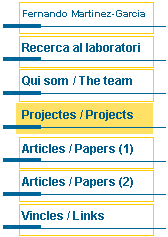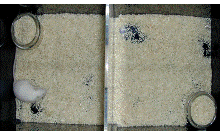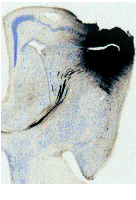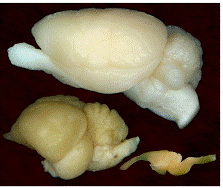
|
Aci trobareu els projectes científics que estem desenvolupant. |
|
Evolució del cervell / Evolution of the Brain |
|
Projectes / Projects |
|
Des de l’any 1983 estem estudiant el cervell de rèptils i, més recentment d’aus. El nostre objectiu és entendre les característiques comunes de l’organització del cervell dels vertebrats. En aquesta feina inabastable ens hem centrat fonamentalment en l’amígdala, però també hem dedicat atenció a d’altres estructures del telencèfal límbic (el septum i l’hipocamp) i al sistema visual a tots els nivells (des de la retina al còrtex visual). Hem col·laborat amb altres grups europeus i nord-americans com ara el dels Drs. Luis Martínez-Millan (Euskal Herriko Unibersitatea, Leioa, Spain), Tomás González-Hernández (Universidad de La Laguna, Tenerife, Spain), Salvador Guirado (Univ. Málaga, Spain), Piet. Hoolgand (Vrije Universiteit, Amsterdam, The Netherlands), Jeús Perez-Clausell (Universitat de Barcelona, Barcelona, Spain), Margarita Belekhova (Russian Academy of Sciences, Saint Petersburgh, Russia), Ceri D Davies (St. George’s Hospital Medical School, London University, UK) i Mimi Halpern (State Universty of New York, Health Science Center at Brooklyn, USA). Since 1986 we have studied the brain of reptiles and, more recently, also the avian brain. Our aim has been to understand the common traits of organisation of the vertebrate brain. In this never-ending task we have focused our attention mainly in the amygdala, but also in other structures of the ‘limbic’ forebrain such as the septum and hippocampus, as well as in the visual systems at all levels (from the retina to the visual cortex). We have collaborated with several grups from Europe and the USA, such as those of Luis Martínez-Millan (Euskal Herriko Unibersitatea, Leioa, Spain), Tomás González-Hernández (Universidad de La Laguna, Tenerife, Spain), Salvador Guirado (Univ. Málaga, Spain), Piet. Hoolgand (Vrije Universiteit, Amsterdam, The Netherlands), Jeús Perez-Clausell (Universitat de Barcelona, Barcelona, Spain), Margarita Belekhova (Russian Academy of Sciences, Saint Petersburgh, Russia), Ceri D Davies (St. George’s Hospital Medical School, London University, UK) i Mimi Halpern (State Universty of New York, Health Science Center at Brooklyn, USA). |
|
L’amígdala és una estructura heterogènia anatòmicament i hi ha qui pensa que també ho es funcionalment. Les seues divisions cortico-medial i basolateral-central semblen actuar en funcions independents relatives a la quimiosensibilitat (corticomedial) y en la gestió de respostes emocionals innates i apreses (basolateral-central). Els resultats de la nostra investigació sobre el valor reforçant d’un estímul vomeronasal, les feromones sexuals als ratolins, suggereixen que totes dues funcions de l’amígdala estan relacionades, donant una explicació funcional a les profuses interconnexions entre les diferents divisions anatòmiques de l’amígdala e diferents vertebrats. The amygdala is an anatomically heterogeneous brain structure and there is people thinking that it is also functionally heterogeneous. In fact, its cortico-medial and basolateral-central divisions area apparently involved in independent functions, related to chemosensibility (cortico-medial) and to eliciting innate and learned emotional responses (basolateral-central). The results of our research on the reinforcing properties of a vomeronasal stimulus, sexual pheromones in mice, suggest that both functions of the amygdala are interrelated, thus giving a functional explanation for the profuse interconnections found between the different divisions of the amygdala in different vertebrates. |
|
Feromones sexuals i reforç als ratolins / Pheromones and reward in mice |





|
Enrique Lanuza Navarro Dept. Biologia Cel·lular i Parasitologia |